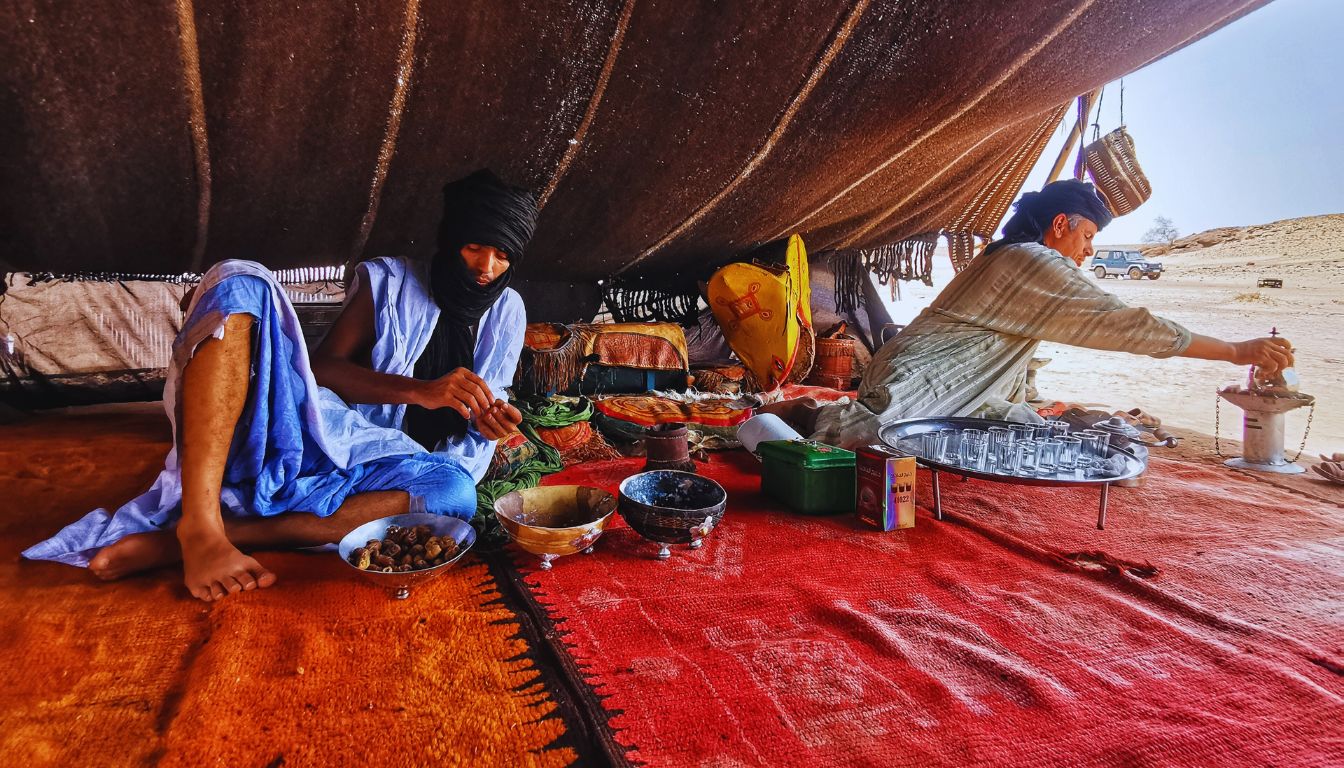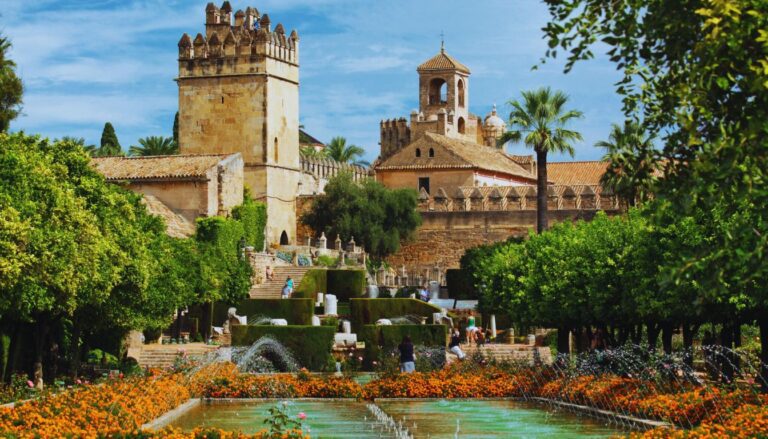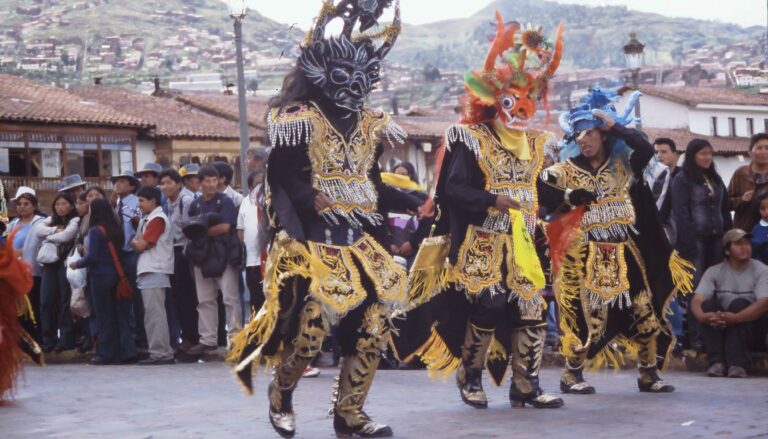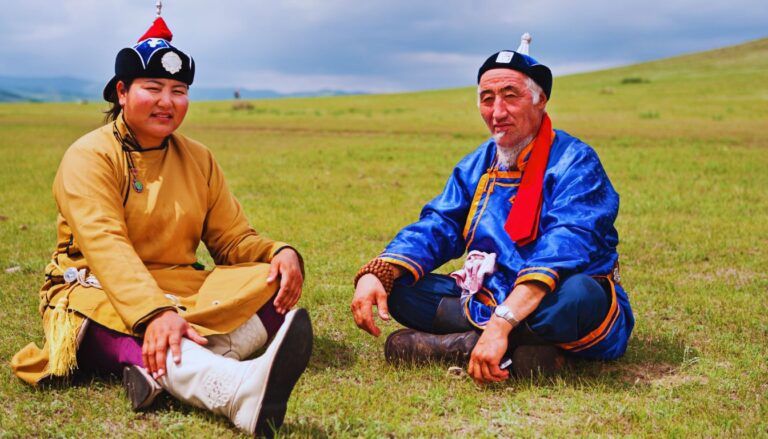The Tuareg, often referred to as the “Blue People” due to the indigo-dyed clothing worn by the men, are a Amazigh ethnic group native to the Sahara Desert. For centuries, these resilient nomads have carved out a unique way of life in one of the world’s most challenging environments. Their rich culture, steeped in tradition and adapted to the harsh desert landscape, has fascinated outsiders for generations.
Primarily inhabiting the Sahara and Sahel regions across several North African countries, including Algeria, Mali, Niger, and Libya, the Tuareg have developed a lifestyle that seamlessly blends ancient practices with the necessities of desert survival.
Table of Contents
Historical Background of Tuareg Culture
The origins of the Tuareg people can be traced back thousands of years to the indigenous Berber populations of North Africa. Their distinct culture began to emerge around 2,000 years ago as they adopted a nomadic lifestyle in response to the increasing desertification of the Sahara.
Throughout history, the Tuareg played a crucial role in trans-Saharan trade, controlling key routes and acting as guides and protectors for caravans crossing the desert. This position allowed them to maintain their independence and unique cultural identity even as powerful empires rose and fell around them.
The arrival of Islam in the region around the 7th century CE had a significant impact on Tuareg culture, blending with their existing beliefs and practices. However, the Tuareg maintained many pre-Islamic traditions, resulting in a unique cultural synthesis.
The Nomadic Lifestyle: Seasonal Movements and Trade Routes
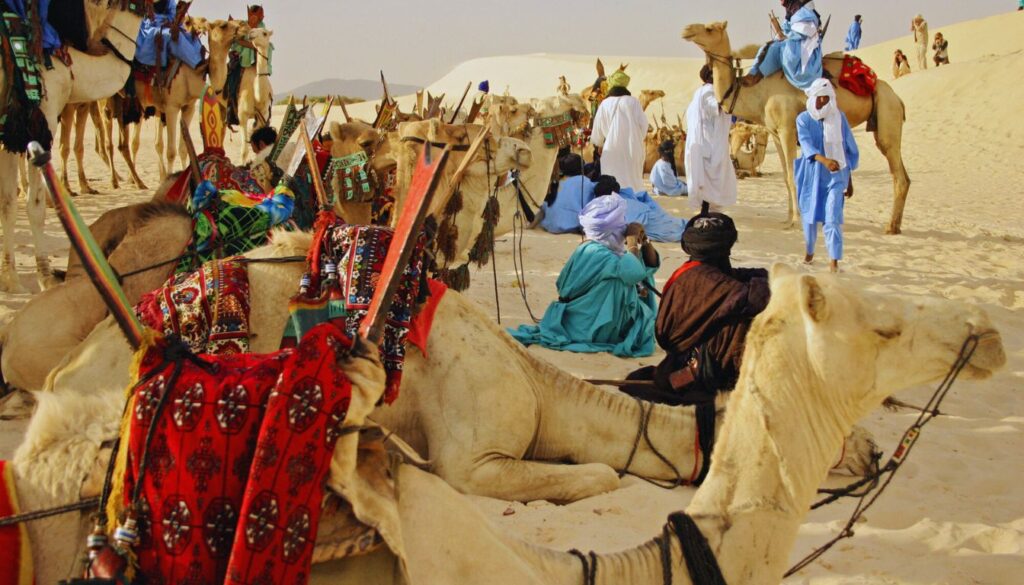
The heart of Tuareg culture lies in their nomadic lifestyle, a practice honed over centuries to survive in the unforgiving Saharan environment. Their movements are dictated by the seasons, available resources, and traditional trade routes.
During the rainy season, typically from July to September, Tuareg families move their herds to southern grasslands where water and vegetation are more abundant. As the dry season approaches, they gradually make their way back north, following ancient paths known only to experienced guides.
These seasonal migrations, known as “transhumance,” are not just about finding pasture for livestock. They’re integral to the Tuareg economy, allowing them to trade goods at various markets along their route. Traditional items for trade include salt, dates, and livestock, which are exchanged for grains, cloth, and other necessities.
The famous salt caravans, where Tuareg guides lead camels laden with salt slabs across the desert, continue to operate today, although on a smaller scale than in the past. These journeys, lasting weeks or even months, are a testament to the Tuareg’s intimate knowledge of the desert and their remarkable endurance.
Tuareg Social Structure and Family Life
Tuareg society is characterized by a complex social hierarchy and strong family bonds. Traditionally, Tuareg society was divided into several classes:
- Nobles (Imajeghen): The warrior class who traditionally owned camels and led raids.
- Vassals (Imghad): Free, but subordinate to the nobles, typically herders and warriors.
- Religious leaders and scholars (Ineslemen): Responsible for education and spiritual guidance.
- Artisans (Inaden): Skilled craftsmen who make jewelry, weapons, and other goods.
- Former slaves and their descendants (Iklan): While slavery is now illegal, this historical class distinction still influences social relations in some areas.
Family life is central to Tuareg culture. Unlike many other Islamic societies, Tuareg culture is matrilineal, meaning that lineage and inheritance are traced through the mother’s line. Women hold a position of respect and authority within the family and community.
Marriage customs among the Tuareg are unique. While Islam allows polygamy, most Tuareg practice monogamy. Divorce is relatively common and socially acceptable, with women often initiating the process. Children typically stay with their mother after a divorce, reflecting the matrilineal nature of Tuareg society.
Traditional Clothing and Adornments
Perhaps the most iconic aspect of Tuareg culture is their traditional clothing, particularly the indigo-dyed veils worn by men. This veil, known as the “tagelmust,” is more than just a piece of cloth; it’s a symbol of manhood and respectability.
Men begin wearing the veil at the age of 25, signifying their transition into full adulthood. The veil serves multiple purposes: it protects from the harsh desert sun and blowing sand, helps retain moisture in the dry climate, and can be used as a form of camouflage. The deep blue color comes from natural indigo dye, which often stains the skin, leading to the nickname “Blue People.”
Tuareg women, on the other hand, do not traditionally wear veils. They often wear colorful robes and headscarves, along with elaborate silver jewelry. Silver is highly prized in Tuareg culture and is believed to have protective properties.
Both men and women wear amulets containing verses from the Quran for protection. These amulets, along with other jewelry, often feature intricate designs that carry symbolic meanings related to Tuareg beliefs and history.
Tuareg Craftsmanship and Art
The Tuareg are renowned for their exceptional craftsmanship, particularly in metalworking. The Inaden, or artisan class, are skilled in creating beautiful and functional items from silver, copper, and other metals.
Some notable examples of Tuareg craftsmanship include:
- Jewelry: Intricate silver necklaces, bracelets, and earrings, often featuring geometric designs.
- Weapons: Finely crafted swords and daggers, both for practical use and as symbols of status.
- Leather goods: Bags, pouches, and saddles made from camel or goat leather, often decorated with geometric patterns.
- Household items: Bowls, utensils, and decorative objects made from wood, metal, or leather.
The designs used in Tuareg art often have deep symbolic meanings, representing elements of their natural environment, spiritual beliefs, or historical events. The transmission of these artistic skills from one generation to the next helps preserve Tuareg cultural heritage.
Language and Oral Traditions
The Tuareg speak various dialects of the Tamasheq language, which belongs to the Berber branch of the Afroasiatic language family. Tamasheq has its own writing system called Tifinagh, an ancient script that has been in use for over 2,000 years.
Oral tradition plays a crucial role in Tuareg culture. Stories, poems, and songs are passed down through generations, preserving history, cultural values, and practical knowledge. The tradition of “Ashamagh,” or poetic duels, showcases the importance of language and wit in Tuareg society.
Storytelling often takes place around the campfire, with skilled narrators weaving tales of ancient heroes, desert spirits, and historical events. These stories serve not only as entertainment but also as a means of education and cultural transmission.
Desert Survival Techniques
Living in the Sahara requires a deep understanding of the desert environment and a set of specialized survival skills. The Tuareg have developed numerous techniques to thrive in this challenging landscape:
- Water conservation: The ability to locate and extract water from plants, and knowledge of hidden water sources.
- Navigation: Using the stars, wind patterns, and subtle landscape features to navigate vast stretches of seemingly featureless desert.
- Weather prediction: Reading natural signs to anticipate sandstorms and rare rainfall.
- Animal husbandry: Raising camels, goats, and sheep that are well-adapted to desert conditions.
- Traditional medicine: Using desert plants for healing and maintaining health in a harsh environment.
These skills are passed down through generations, often through practical instruction during the day-to-day activities of nomadic life. The Tuareg’s intimate knowledge of their environment has allowed them to survive and even thrive in conditions that would be deadly to the unprepared.
Tuareg Cuisine and Food Practices
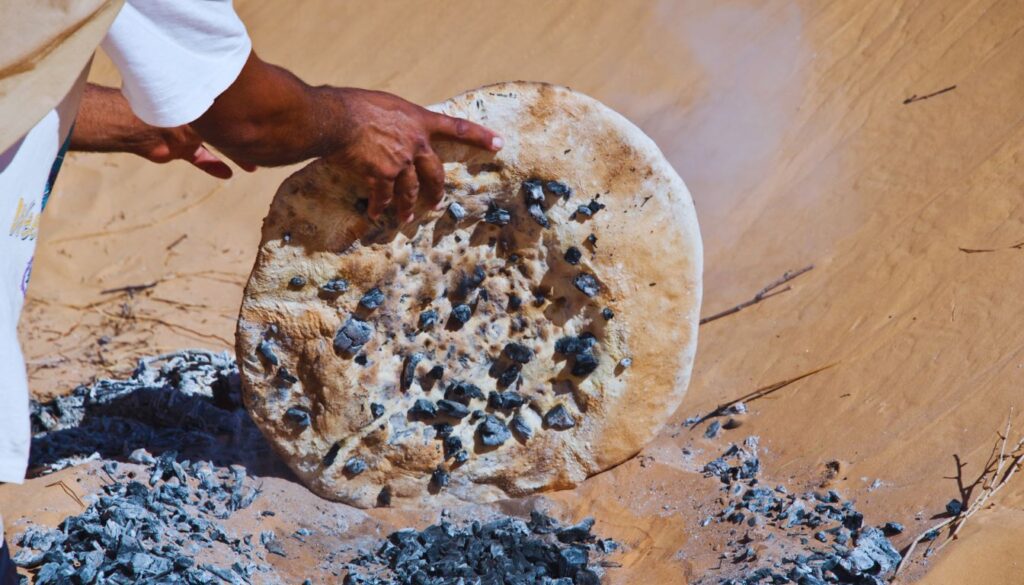
Tuareg cuisine is adapted to the scarcity of resources in the desert and the practicalities of nomadic life. Their diet primarily consists of:
- Dairy products: Milk, cheese, and butter from camels, goats, and sheep.
- Grains: Millet and sorghum, often prepared as porridge or flatbread.
- Meat: Primarily from their herds, consumed fresh or dried for preservation.
- Dates: A staple food rich in energy and easily transported.
- Wild plants: Various desert plants used for nutrition and medicinal purposes.
One of the most iconic Tuareg food practices is the elaborate tea ceremony. Green tea, often mixed with mint and a generous amount of sugar, is prepared and served in a specific ritual that can last for hours. This ceremony is not just about refreshment; it’s a social event that reinforces community bonds.
Food preparation and consumption are often communal activities, reflecting the strong social ties within Tuareg society. Sharing meals is an important aspect of hospitality, with guests always offered food and drink, even when resources are scarce.
Music and Festivals in Tuareg Culture
Music plays a vital role in Tuareg culture, serving as both entertainment and a means of cultural expression. Traditional Tuareg music features stringed instruments like the imzad (a one-stringed fiddle played by women) and the tehardent (a three-stringed lute), along with drums and vocal performances.
In recent years, Tuareg rock music, sometimes called “desert blues,” has gained international recognition. Bands like Tinariwen have brought Tuareg music to global audiences, blending traditional sounds with modern electric guitars.
Festivals are an important part of Tuareg social life, providing opportunities for different groups to come together, celebrate, and reinforce cultural ties. Some notable Tuareg festivals include:
- Cure Salée: An annual gathering of nomadic peoples in Niger, featuring music, camel races, and trading.
- Tamasheq Cultural Festival: Held in Mali, this event showcases Tuareg music, dance, and crafts.
- Ghat Festival: A celebration of Tuareg culture in southern Libya, featuring traditional games, music, and camel races.
These festivals not only serve as joyous occasions but also play a crucial role in maintaining Tuareg cultural identity and social cohesion in the face of modernization and political challenges.
Challenges to Traditional Tuareg Life in the Modern Era
While the Tuareg have successfully adapted to the harsh desert environment for centuries, they face numerous challenges in the modern world:
- Climate change: Increasing desertification and unpredictable weather patterns are affecting traditional migration routes and livelihoods.
- Political instability: Conflicts in the Sahel region have disrupted traditional Tuareg territories and ways of life.
- Economic pressures: The decline of traditional caravan trade and the lure of urban economies are changing Tuareg economic practices.
- Education and healthcare: Accessing modern services while maintaining a nomadic lifestyle presents significant challenges.
- Cultural preservation: Balancing traditional practices with modernization and global influences is an ongoing struggle.
Despite these challenges, many Tuareg communities are finding ways to adapt. Some are incorporating modern technologies into their nomadic lifestyle, such as using solar panels for electricity or mobile phones for communication. Others are diversifying their economic activities, getting involved in tourism or artisanal mining while still maintaining aspects of their traditional culture.
Conclusion: Preserving Tuareg Heritage in a Changing World
The Tuareg people, with their rich cultural heritage and remarkable adaptability, stand as a testament to human resilience in the face of environmental extremes. Their nomadic lifestyle, craftsmanship, oral traditions, and intimate knowledge of the desert environment offer valuable lessons in sustainability and cultural preservation.
As the world changes, the Tuareg face the challenge of maintaining their unique identity while adapting to new realities. Efforts to preserve Tuareg heritage are ongoing, with initiatives focusing on documenting oral traditions, promoting traditional crafts, and supporting sustainable tourism that respects Tuareg culture.
The future of Tuareg nomadic life remains uncertain, but the resilience and adaptability that have allowed this remarkable culture to thrive in the Sahara for centuries continue to serve them well. As they navigate the complexities of the modern world, the Tuareg remind us of the importance of cultural diversity and the enduring human capacity to find home in even the most challenging environments.
In a world grappling with environmental challenges and rapid cultural change, the wisdom embedded in Tuareg traditions – their sustainable use of scarce resources, their strong community bonds, and their harmonious relationship with a harsh environment – offers valuable insights for us all. As we look to the future, preserving and learning from cultures like the Tuareg may prove crucial in our collective journey towards a more sustainable and culturally rich world.
Discover the must-visit cultural destinations of Tuareg culture

